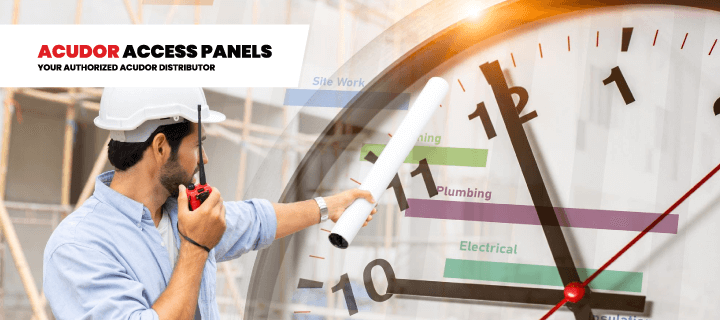3 Duct Types That Drive HVAC Efficiency and Air Quality in Commercial Projects Posted by Acudor Access Panels on 8th Jul 2025
HVAC issues often stay hidden at first. Everything seems fine, but after a few months, the complaints start. One space feels too hot, another too cold. Energy costs go up, and maintenance teams are left chasing airflow problems that never seem to go away.
The real cause is often the duct system. Performance slips when duct type, layout, and access aren’t planned together as part of a complete design. Airflow becomes uneven, air quality drops, and energy use rises, bringing extra costs and plenty of frustration.
Often, duct systems miss internal lining that helps manage noise, moisture, or airflow. Some combine mismatched shapes or materials that hurt performance, while others leave access points that are key for fire code compliance and keeping airflow efficient.
The best way to avoid these problems is to make smart duct choices. Below are three essential duct types that help support HVAC efficiency and deliver the performance your project needs.
1. Sheet Metal Ducts: Rigid and Reliable
Sheet metal ducts, usually made from galvanized steel or aluminum, are a staple in commercial HVAC for good reasons. Their rigid structure holds shape over long runs, resists damage, and supports high airflow rates with minimal friction loss.
The clean, smooth interior allows efficient airflow and is less likely to trap dust, mold, or moisture. That helps preserve air quality while reducing the strain on fans and motors.
But sheet metal systems require consistent inspection to stay that way. Poorly sealed joints, insulation damage, or corrosion can develop over time, especially when ductwork inspection access is limited or overlooked.
With proper installation and the right commercial HVAC duct access panels, crews can monitor performance, verify airflow, and make repairs without cutting into ceilings or walls.
This access is also important for projects targeting green building certifications, where long-term efficiency and maintainability are key evaluation points.
2. Fiberglass-Lined Ducts: Acoustic and Thermal-Efficient
Fiberglass-lined ducts start with a sheet metal base and add an internal insulation layer. This design reduces thermal transfer and dampens noise from the air handler—a major benefit in buildings where occupant comfort matters, such as schools, corporate offices, and hospitals.
They also help lower energy use by keeping air at the target temperature as it moves through the system. But their performance depends heavily on routine upkeep. Over time, moisture can compromise insulation. Fiberglass particles may loosen, and if left unchecked, can circulate through the building, prompting costly complaints or repairs.
Related: Best Access Doors' Comprehensive Guide to Different Types of Duct Systems
3. Flexible Ducts: Adaptable and Affordable
Flexible ducts are one of the most used duct types for commercial buildings, especially in retail spaces, multi-use developments, and tenant improvements. Made of a plastic core wrapped with insulation and supported by a spiral wire frame, they’re lightweight, adaptable, and easy to install.
They're common in retail spaces, multi-use buildings, and tenant improvements because of their quick install time and lower cost. And since flex ducts are more prone to physical damage or insulation collapse, they need regular visual checks to ensure performance won’t degrade.
Is your duct strategy built to last? Reliable performance begins with proper access. Ensure your system supports both airflow and inspection. Call us at +1 (888) 617-4472 to discuss your project!
Related: Duct Access Doors and Panels For Easier Cleaning and Maintenance
Why the Right Access Door Makes All the Difference
Even the most efficient duct system can fall short without reliable access to maintenance. That’s where the WD-8000 Walk Through Access Door earns its place in your system design.
The WD-8000 is engineered for high-traffic commercial settings where full-sized access to HVAC systems is non-negotiable. This door gives technicians safe, durable access to inspect ductwork without delay, helping maintain energy efficiency through regular checks and quick response to performance issues.
Key benefits:
- Supports repeated access without compromising structural integrity
- Allows easy movement of equipment and tools during inspections
- Accommodates ladder entry for ceiling or overhead ductwork
- Speeds up routine maintenance and emergency response
- Helps protect indoor air quality with faster service access
- Reduces costly downtime and improves service workflow
Ensure your HVAC system is built for inspection, efficiency, and reliable results with custom solutions designed to fit your project needs. Contact us to get started!
To Sum It Up
Ductwork is the backbone of HVAC performance, and access plays a bigger role in energy efficiency, air quality, and cost control than many teams expect. Reliable access is what keeps systems running at their best over time.
When access and duct design work together, maintenance becomes proactive instead of reactive. That means fewer service calls, smoother inspections, and systems that hold up long after handoff. For project leads balancing deadlines, budgets, and performance metrics, these small design decisions can drive big wins—on day one and years down the line.
At Acudor Access Panels, we provide access solutions from fire-rated access panels to smoke vents that support easier maintenance and help prevent issues down the line. Call us at +1 (888) 617-4472 or request a quote today.
Acudor Access Panels is a trusted and authorized distributor of Acudor products. We are proud to bring you their full range of industry-leading access doors and panels.





